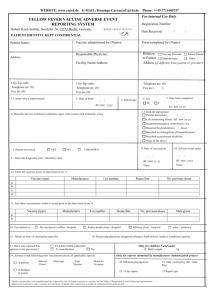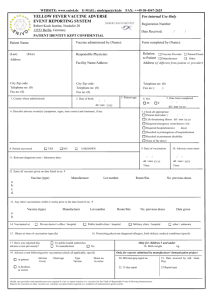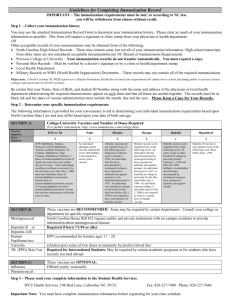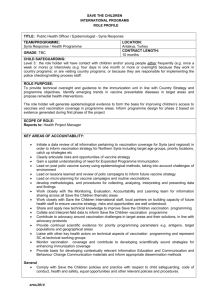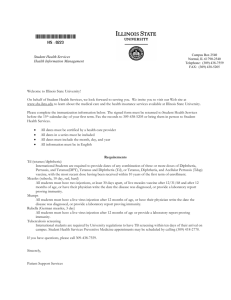הודעה על החמרה ( מידע בטיחות) בעלון לצרכן
advertisement
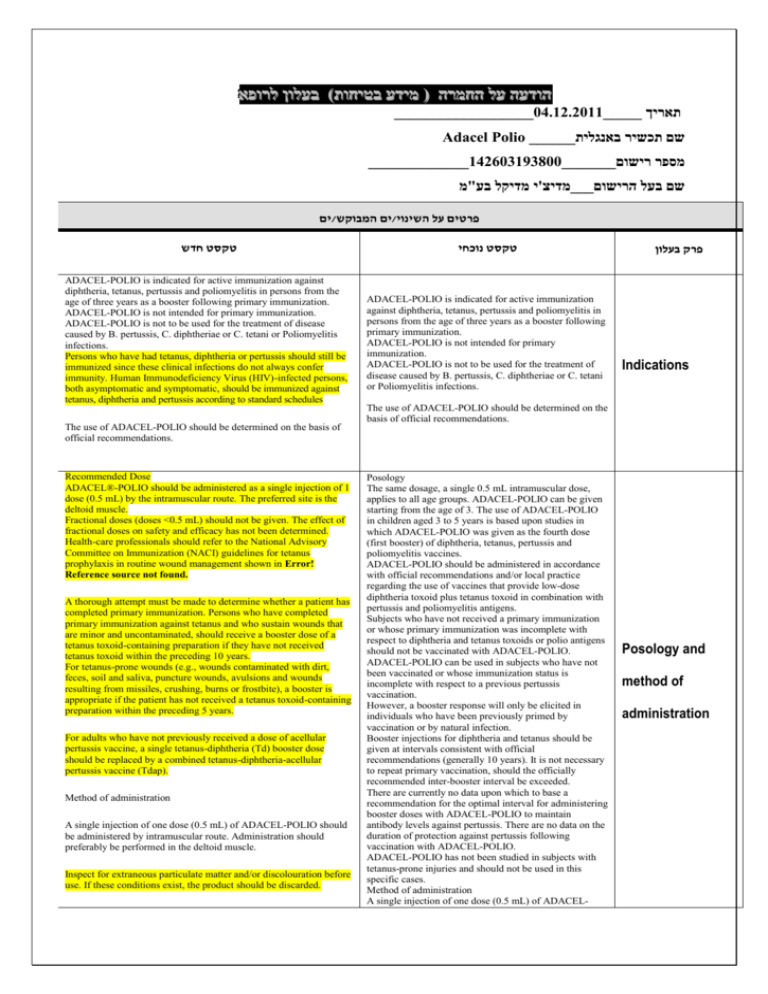
לרופא בעלון לרופא בטיחות) בעלון )מידע בטיחות החמרה (( מידע על החמרה הודעה על הודעה __________________04.12.2011_____ תאריך Adacel Polio ______שם תכשיר באנגלית _____________142603193800_______מספר רישום שם בעל הרישום___מדיצ'י מדיקל בע"מ ים/ים המבוקש/פרטים על השינוי טקסט חדש טקסט נוכחי ADACEL-POLIO is indicated for active immunization against diphtheria, tetanus, pertussis and poliomyelitis in persons from the age of three years as a booster following primary immunization. ADACEL-POLIO is not intended for primary immunization. ADACEL-POLIO is not to be used for the treatment of disease caused by B. pertussis, C. diphtheriae or C. tetani or Poliomyelitis infections. Persons who have had tetanus, diphtheria or pertussis should still be immunized since these clinical infections do not always confer immunity. Human Immunodeficiency Virus (HIV)-infected persons, both asymptomatic and symptomatic, should be immunized against tetanus, diphtheria and pertussis according to standard schedules ADACEL-POLIO is indicated for active immunization against diphtheria, tetanus, pertussis and poliomyelitis in persons from the age of three years as a booster following primary immunization. ADACEL-POLIO is not intended for primary immunization. ADACEL-POLIO is not to be used for the treatment of disease caused by B. pertussis, C. diphtheriae or C. tetani or Poliomyelitis infections. The use of ADACEL-POLIO should be determined on the basis of official recommendations. Recommended Dose ADACEL®-POLIO should be administered as a single injection of 1 dose (0.5 mL) by the intramuscular route. The preferred site is the deltoid muscle. Fractional doses (doses <0.5 mL) should not be given. The effect of fractional doses on safety and efficacy has not been determined. Health-care professionals should refer to the National Advisory Committee on Immunization (NACI) guidelines for tetanus prophylaxis in routine wound management shown in Error! Reference source not found. A thorough attempt must be made to determine whether a patient has completed primary immunization. Persons who have completed primary immunization against tetanus and who sustain wounds that are minor and uncontaminated, should receive a booster dose of a tetanus toxoid-containing preparation if they have not received tetanus toxoid within the preceding 10 years. For tetanus-prone wounds (e.g., wounds contaminated with dirt, feces, soil and saliva, puncture wounds, avulsions and wounds resulting from missiles, crushing, burns or frostbite), a booster is appropriate if the patient has not received a tetanus toxoid-containing preparation within the preceding 5 years. For adults who have not previously received a dose of acellular pertussis vaccine, a single tetanus-diphtheria (Td) booster dose should be replaced by a combined tetanus-diphtheria-acellular pertussis vaccine (Tdap). Method of administration A single injection of one dose (0.5 mL) of ADACEL-POLIO should be administered by intramuscular route. Administration should preferably be performed in the deltoid muscle. Inspect for extraneous particulate matter and/or discolouration before use. If these conditions exist, the product should be discarded. פרק בעלון Indications The use of ADACEL-POLIO should be determined on the basis of official recommendations. Posology The same dosage, a single 0.5 mL intramuscular dose, applies to all age groups. ADACEL-POLIO can be given starting from the age of 3. The use of ADACEL-POLIO in children aged 3 to 5 years is based upon studies in which ADACEL-POLIO was given as the fourth dose (first booster) of diphtheria, tetanus, pertussis and poliomyelitis vaccines. ADACEL-POLIO should be administered in accordance with official recommendations and/or local practice regarding the use of vaccines that provide low-dose diphtheria toxoid plus tetanus toxoid in combination with pertussis and poliomyelitis antigens. Subjects who have not received a primary immunization or whose primary immunization was incomplete with respect to diphtheria and tetanus toxoids or polio antigens should not be vaccinated with ADACEL-POLIO. ADACEL-POLIO can be used in subjects who have not been vaccinated or whose immunization status is incomplete with respect to a previous pertussis vaccination. However, a booster response will only be elicited in individuals who have been previously primed by vaccination or by natural infection. Booster injections for diphtheria and tetanus should be given at intervals consistent with official recommendations (generally 10 years). It is not necessary to repeat primary vaccination, should the officially recommended inter-booster interval be exceeded. There are currently no data upon which to base a recommendation for the optimal interval for administering booster doses with ADACEL-POLIO to maintain antibody levels against pertussis. There are no data on the duration of protection against pertussis following vaccination with ADACEL-POLIO. ADACEL-POLIO has not been studied in subjects with tetanus-prone injuries and should not be used in this specific cases. Method of administration A single injection of one dose (0.5 mL) of ADACEL- Posology and method of administration Shake the vial or syringe well until a uniform, cloudy, suspension results. When administering a dose from a stoppered vial, do not remove either the stopper or the metal seal holding it in place. Use a separate sterile needle and syringe, or a sterile disposable unit for each individual patient to prevent disease transmission. Needles should not be recapped but should be disposed of according to biohazard waste guidelines. POLIO should be administered by intramuscular route. Administration should preferably be performed in the deltoid muscle. ADACEL-POLIO should not be administered into the buttock area. Do not inject by intravascular route. The subcutaneous route should not be used (for exception, see section 4.4). Before injection, the skin over the site to be injected should be cleansed with a suitable germicide. Hypersensitivity to the active substances, to any of the excipients or any residual component carried over from manufacture (formaldehyde, gluteraldehyde, streptomycin, neomycin and polymyxin B). ■ Anaphylactic or other allergic reactions to a previous dose of a vaccine containing diphtheria or tetanus toxoids, poliomyelitis viruses or pertussis (acellular or whole cell). ■ Evolving encephalopathy: ADACEL-POLIO should not be administered to subjects who experienced an encephalopathy of unknown origin within 7 days of previous immunization with a pertussis-containing vaccine, or to subjects who have experienced other neurological complications following previous immunization with any of the antigens in ADACEL-POLIO. ■ Hypersensitivity to the active substances, to any of the excipients or any residual component carried over from manufacture (formaldehyde, gluteraldehyde, streptomycin, neomycin and polymyxin B). ■ Anaphylactic or other allergic reactions to a previous dose of a vaccine containing diphtheria or tetanus toxoids, poliomyelitis viruses or pertussis (acellular or whole cell). ■ Evolving encephalopathy: ADACEL-POLIO should not be administered to subjects who experienced an encephalopathy of unknown origin within 7 days of previous immunization with a pertussis-containing vaccine, or to subjects who have experienced other neurological complications following previous immunization with any of the antigens in ADACELPOLIO. Vaccination should be deferred in the presence of any acute illness, particularly febrile illness. A minor afebrile illness such as mild upper respiratory infection does not usually entail vaccination postpone. ADACEL-POLIO should not be administered as primary immunization or as boosters in children less than 3 years of age. The administration of ADACEL-POLIO, should be preceded by asking the vaccinated subject's parents/guardians about his/her personal and family history his/her recent health status, including vaccination The rates and severity of adverse events in recipients of tetanus history, current health status and any undesirable effects toxoid are influenced by the number of prior doses and level of prefollowing previous vaccinations. existing antitoxins. The rates and severity of adverse events in recipients of As with any vaccine, ADACEL®-POLIO may not protect 100% of tetanus toxoid are influenced by the number of prior doses vaccinated persons. and level of pre-existing antitoxins. Febrile and Acute Disease: Vaccination should be postponed in As with any vaccine, ADACEL®-POLIO may not protect cases of an acute or febrile disease. However, a disease with low100% of vaccinated persons. grade fever should not usually be a reason to postpone vaccination. If Guillain-Barré syndrome has occurred of prior vaccine Neurologic: ADACEL®-POLIO should not be administered to individuals containing with tetanus toxoid, the decision to give progressive neurological disorder, uncontrolled epilepsy, or progressive ADACEL®-POLIO or any vaccine containing tetanus encephalopathy until a treatment regimen has been established and the condition toxoid should has be based on careful consideration of the stabilized. A review by the US Institute of Medicine (IOM) found evidence potential for a benefits and possible risks such as whether the causal relation between tetanus toxoid and both brachial neuritis and Guillain-Barré primary immunization schedule is complete or not. syndrome. If Guillain-Barré syndrome has occurred within 6 weeks of receipt The decision of to administer the Adacel-Polio vaccine prior vaccine containing tetanus toxoid, the decision to give ADACEL®-POLIO should be or taken with care in people who have already any vaccine containing tetanus toxoid should be based on careful consideration experienced of serious or severe reaction within 48 hours of the potential benefits and possible risks a previous injection of a vaccine containing the same Immune The possibility of allergic reactions in persons sensitive to components substances. of the vaccine should be evaluated. Hypersensitivity reactions may occur following the use of ADACEL®-POLIO even in persons with no prior history of hypersensitivity As with all injectable vaccines, appropriate medical to the product components. treatment should be readily available and supervision As with all other products, epinephrine hydrochloride solution provided in the event of rare anaphylactic reaction (1:1,000) and other appropriate agents should be available for following the administration of the vaccine. immediate use in case an anaphylactic or acute hypersensitivity reaction occurs. Health-care providers should be familiar with current recommendations for the initial management of anaphylaxis As with all other products, appropriate agents should be in non-hospital settings, including proper airway management. available for immediate use in case an anaphylactic or Immunocompromised persons (whether from disease or treatment) acute hypersensitivity reaction occurs. may not achieve the expected immune response. If possible, Immunocompromised persons (whether from disease or consideration should be given to delaying vaccination until after the treatment) may not achieve the expected immune completion of any immunosuppressive treatment. Nevertheless, response. If possible, consideration should be given to vaccination of persons with chronic immunodeficiency, such as HIV delaying vaccination until after the completion of any infection, is recommended even if the immune response might be immunosuppressive treatment. Nevertheless, vaccination Contraindications General The administration of ADACEL-POLIO, should be preceded by asking the vaccinated subject's parents/guardians about his/her personal and family history his/her recent health status, including vaccination history, current health status and any undesirable effects following previous vaccinations. Special warnings and precautions for use limited. Administration Route Related Precautions Do not administer by the intravascular route ensure that the needle does not penetrate a blood vessel. Intradermal or subcutaneous routes of administration are not to be utilized. ADACEL®-POLIO should not be administered into the buttocks. Hematologic Because any intramuscular injection can cause an injection site hematoma in persons with any bleeding disorders, such as haemophilia or thrombocytopenia, or in persons on anticoagulant therapy, intramuscular injections with ADACEL®-POLIO should not be administered to such persons unless the potential benefits outweigh the risk of administration. If the decision is made to administer any product by intramuscular injection to such persons, it should be given with caution, with steps taken to avoid the risk of hematoma formation following injection. of persons with chronic immunodeficiency, such as HIV infection, is recommended even if the immune response might be limited. Do not administer by the intravascular route. Once the needle is inserted, aspirate in order to make sure the needle has not penetrated a blood vessel. Fractional doses (doses <0.5 mL) should not be given. The effect of fractional doses on the frequency of serious adverse events and on efficacy have not been determined. Local recommendations should be followed with respect to time interval before injection of a booster dose of ADACEL-POLIO. However, in order to minimize the risk of adverse reactions, a time interval of at least five years is recommended between a booster dose of ADACEL-POLIO and previous booster doses of vaccines containing diphtheria and tetanus valences (DT, Td). Because any intramuscular injection can cause an injection site hematoma in persons with any bleeding disorders, or in persons on anticoagulant therapy. In these situations administration of ADACEL-POLIO by deep subcutaneous injection may be considered, even if there is an increased risk of local reactions. If the decision is made to administer any product by intramuscular injection to such persons, it should be given with caution As with all adsorbed vaccines, particularly if administered into the superficial layers of the subcutaneous tissue, a persistent nodule at the site of injection may occur. Vaccination is usually justified for infants whose primary immunization schedules are incomplete (i.e., less than three doses administered). Supportive data from a study conducted with ADACEL® suggests that ADACEL®-POLIO may be used concomitantly with trivalent influenza vaccine. ADACEL®-POLIO has been safely administered concomitantly with measles-mumps-rubella vaccine in noncontrolled clinical studies in children 3 to 5 years of age. Data are not available on concomitant use of ADACEL®-POLIO and varicella vaccine. Administering the most widely used live and inactivated vaccines during the same patient visit has produced seroconversion rates and rates of adverse reactions similar to those observed when the vaccines are administered separately. Vaccines administered concomitantly should be given using separate syringes at separate sites. Simultaneous administration is suggested, particularly when there is concern that a person may not return for subsequent vaccination. ADACEL®-POLIO should not be mixed in the same syringe with other parenterals. The effect of ADACEL-POLIO on embryo-foetal development has not been assessed. Limited post-marketing data is available following administration of ADACEL®-POLIO in pregnant women. Vaccination in pregnancy is not recommended unless there is a definite risk of acquiring pertussis. As the vaccine is inactivated, risk to the embryo or the fetus is improbable. The benefits versus the risks of administering ADACEL®-POLIO during pregnancy should be carefully evaluated when there is a high probable risk of exposure to a household contact or during an outbreak in the community. A clinical study has shown that ADACEL-POLIO can be administered concomitantly with hepatitis B vaccine, using a separate limb for the site of injection. No interaction studies have been carried out with other vaccines, biological products or medicinal products. However, in accordance with commonly accepted vaccination recomindations, as with any inactivated vaccine, there is no theoretical reason why Adacel Polio should not be administered concomitantly with other vaccines or immunoglobulins at separate injection sites. In the case of immunosuppressive therapy please refer to section 4.4. Interaction with other medicinal products and other forms of interaction The effect of ADACEL-POLIO on embryo-foetal development has not been assessed. No teratogenic effect have been observed following administration to pregnant women of vaccines containing diphtheria or tetanus toxoids, or inactivated poliovirus. There are no available data on the use of vaccines containing acellular pertussis antigens in pregnant women. The use of this combined vaccine is not recommended during pregnancy. Pregnancy and lactation Because clinical trials are conducted under widely varying conditions, adverse reaction rates observed in the clinical trials of a vaccine cannot be directly compared to rates in the clinical trials of another vaccine and may not reflect rates observed in practice. The adverse reaction information from clinical trials does, however, provide a basis for identifying the adverse events that appear to be related to vaccine use and for approximating rates of those events. The safety of ADACEL®-POLIO has been evaluated in a total of 1,636 participants who received a single dose of ADACEL®-POLIO in 7 clinical trials (644 children 3 to 7 years of age, 992 adolescents and adults 11 to 60 years of age). Pain was the most common injection site reaction in all age groups. Most injection site reactions occurred within 3 days following vaccination. The most frequent systemic reaction was headache in adolescents and adults and tiredness in children. These reactions were usually transient and of mild to moderate intensity. Table presents the frequencies of the solicited injection site and systemic adverse events reported in 3 UK clinical trials in which children previously primed with 3 doses of PEDIACEL® [Diphtheria and Tetanus Toxoids and Acellular Pertussis Vaccine Adsorbed Combined with Inactivated Poliomyelitis Vaccine and Haemophilus b Conjugate Vaccine (Tetanus Protein – Conjugate)] or a whole-cell pertussis combination vaccine, received a pre-school booster dose of ADACEL®-POLIO at 3 to 5 years of age. In addition, adverse events of irritability (7.3%), injection site bruising (3.3%), injection site pruritus (2.7%) and dermatitis (1.3%) were reported within 7 days of vaccination in two of these studies. In clinical trials in children ADACEL®-POLIO showed a comparable safety profile to that of ADACEL® [Tetanus Toxoid, Reduced Diphtheria Toxoid and Acellular Pertussis Vaccine Adsorbed]. Therefore, the safety of ADACEL®-POLIO, in particular for use as a 4 to 6 years-old booster dose is further supported by a study conducted with ADACEL® in 298 children. The frequency of the solicited injection site and systemic adverse events reported in a Canadian clinical trial in adolescents and adults are also presented in Table Table 2: Frequency (%) of Solicited Reactions Observed in Clinical Trials in Children, Adolescents and Adults, Following a Single Booster Dose of ADACEL®-POLIO Children Adolescents Adults 3 to 5 Years 12 to 18 Years of 19 to 60 Years Ageii of Ageii Solicited of Agei Reactions (N = 307) (N = 350) (N = 366) Injection Site Reactions Pain 46.5 – 71.3 88.3 86.3 Swelling 20.4 – 34.0 21.2 16.7 Redness 35.7 – 48.7 17.5 23.0 Data from clinical trials In clinical trials conducted with ADACEL-POLIO, the vaccine was administered to 1,384 children, adolescent and adult subjects. The most commonly reported reactions following vaccination were local injection site reactions (pain, redness and swelling). These signs and symptoms were usually of mild intensity and appeared within 48 hours of vaccination. They all resolved without sequelae. Adverse reactions are ranked under headings of frequency using the following convention: Very common ( 1/10) Common ( 1/100 to <1/10) Uncommon ( 1/1,000 to <1/100) Rare ( 1/10,000 to <1/1,000) Very Rare (<1/10,000), including individual cases Adolescents and adults (994 subjects) Clinical studies in which ADACEL-POLIO was administered to adolescents and adults have shown that the most frequently reported adverse reactions, whatever the age group, appearing within 24 hours of vaccination were as follows: Nervous System Disorders Very common: Gastrointestinal Disorders Very Nausea Common: Common: Headache Nausea Diarrhea Vomiting Body Ache Sore or Swollen Joints Tiredness Chills Rash 7.0 – 12.7 N.S. N.S. 7.6 – 10.0 2.5 – 6.7 N.S. 14.2 41.3 17.5 5.4 3.2 26.1 2.7 37.7 14.5 15.8 2.5 24.0 1.3 11.2 11.2 35.7 – 52.7 N.S. 7.0 – 8.7 37.2 17.5 N.S. 29.8 11.2 N.S. Adverse reactions reported within 7 days of vaccination. Range of frequencies across 3 UK studies. Adverse reactions reported within 14 days of vaccination. Fever was defined as temperature ≥37.5°C in children, 38.0°C vomiting, diarrhoea Musculoskeletal and Connective Tissue Disorders Very Common: Systemic Reactions Feveriii Headache arthralgia/ joint swelling, myalgia General Disorders and Administration Site Conditions Very common: asthenia, chills, injection site pain, swelling, erythema Common: fever 38.0°C There was a trend for higher rates for local and general reactions in adolescents than in adults. In both age groups, injection site pain was the most common adverse reaction. Late-onset local adverse reactions (i.e. a local adverse reaction which had an onset or increase in severity 3 to 14 days after a vaccination), such as injection site pain, erythema and swelling occurred in less than 1.2% of cases. Adverse events in adolescents and adults. Fever was solicited up to 7 days postvaccination in children, up to 72 hours in adolescents and adults. N.S.: Not solicited. Children 5 to 6 years old (240 subjects) In a clinical trial, children received a primary immunization with a combined diphtheria, tetanus and acellular pertussis vaccine administered at 3, 5 and 12 months, with no additional dose in the second year of life. These children received ADACEL-POLIO at the age of 5 to 6 years. The most frequently reported adverse reactions observed undesirable effects appearing within 24 hours of administration were as follows: Data from postmarketing experienceIn addition to the data obtained from clinical studies, the following adverse events have been reported during the commercial use of ADACEL-POLIO. The adverse events have been very rarely reported (<0.01%); however, the exact incidence rates cannot precisely be assessed. Calculation is based on the number of adverse events compared with the estimated number of vaccinated subjects. Blood and lymphatic disorders: Lymphadenopathy Nervous system disorders: convulsions, vasovagal syncope, Guillain Barre syndrome, facial palsy, myelitis, brachial neuritis, transient paresthesia / hypoesthesia of vaccinated limb, dizziness. General disorders and administrative site conditions: Injection site indurations Extensive limb swelling from the injection site beyond one or both joints and frequently associated with erythema, sometimes with blisters has been reported after the administration of ADACELPOLIO. Most reactions appeared within 48 hours of vaccination and spontaneously resolved without sequelae whithin 4 days on average. The risk seems to be dependent on the number of doses of d/DtaP vaccine previously administered, with a risk increased after the 4 th and 5th doses. Malaise, Pallor Musculoskeletal and connective tissue disorders: pain in vaccinated limb Immune system disorders:Anaphylactic reactions, such as urticaria, face oedema and dyspnea Gastrointestinal Disorders Uncommo Diarrhoea, n: vomiting General Disorders and Administration Site Conditions Very common: fatigue, injection site pain, swelling Common: fever 38.0°C, injection site erythema and pruritus The rates of general symptoms on the day after vaccination and during the next 10 days were low; only fever ( 38.0°C) and fatigue were reported in more than 10% of the cases. Severe transient swelling of the arm have been reported in less than 1% of the cases. Children 3 to 5 years old (150 subjects) 150 children received a primary immunization at 2, 3, and 4 months of age with a with a combined diphtheria, tetanus and whole cell pertussis vaccine (with no additional dose in the second year of life) were vaccinated with ADACEL-POLIO at the age of 3 to 5 years. The most frequently reported adverse reactions appearing within the first 7 days after administration were as follows: Gastrointestinal Disorders Common: nausea, vomiting, diarrhoea Skin and Subcutaneous System Disorders Common: rash General Disorders and Administration Site Conditions Very common: fatigue, fever 37.5°C, irritability, injection site pain, swelling, erythema Common: Injection site bruising and dermatitis Data from postmarketing experienceIn addition to the data obtained from clinical studies, the following adverse events have been reported during the commercial use of ADACEL-POLIO. The adverse events have been very rarely reported (<0.01%); however, the exact incidence rates cannot precisely be assessed. Calculation is based on the number of adverse events compared with the estimated number of vaccinated subjects. Blood and lymphatic disorders: Lymphadenopathy General disorders and administrative site conditions: Extensive limb swelling from the injection site beyond one or both joints and frequently associated with erythema, sometimes with blisters has been reported after the administration of ADACEL-POLIO. Most reactions appeared within 48 hours of vaccination and spontaneously resolved without sequelae whithin 4 days on average. The risk seems to be dependent on the number of doses of d/DtaP vaccine previously administered, with a risk increased after the 4th and 5th doses. Malaise, Pallor Immune system disorders:Anaphylactic reactions, such as urticaria, face oedema and dyspnea Potential adverse events Other adverse events not mentioned above were reported with other similar vaccines and should be considered as potential adverse reactions of ADACEL-POLIO. Brachial neuritis and Guillain-Barré syndrome after administration of a tetanus toxoid containing vaccine. i Adverse reactions reported within 7 days of vaccination. Range of frequencies across 3 UK studies. ii Adverse reactions reported within 14 days of vaccination. iii Fever was defined as temperature ≥37.5°C in children, 38.0°C in adolescents and adults. Fever was solicited up to 7 days post-vaccination in children, up to 72 hours in adolescents and adults. N.S.: Not solicited.
